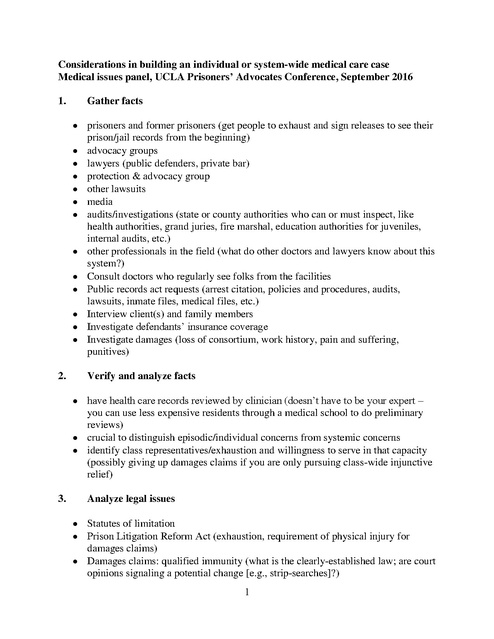Considerations in building an individual or system-wide medical care case, Medical issues panel, UCLA Prisoners’ Advocates Conference, September 2016
Download original document:

Document text

Document text
This text is machine-read, and may contain errors. Check the original document to verify accuracy.
Considerations in building an individual or system-wide medical care case Medical issues panel, UCLA Prisoners’ Advocates Conference, September 2016 1. Gather facts prisoners and former prisoners (get people to exhaust and sign releases to see their prison/jail records from the beginning) advocacy groups lawyers (public defenders, private bar) protection & advocacy group other lawsuits media audits/investigations (state or county authorities who can or must inspect, like health authorities, grand juries, fire marshal, education authorities for juveniles, internal audits, etc.) other professionals in the field (what do other doctors and lawyers know about this system?) Consult doctors who regularly see folks from the facilities Public records act requests (arrest citation, policies and procedures, audits, lawsuits, inmate files, medical files, etc.) Interview client(s) and family members Investigate defendants’ insurance coverage Investigate damages (loss of consortium, work history, pain and suffering, punitives) 2. Verify and analyze facts have health care records reviewed by clinician (doesn’t have to be your expert – you can use less expensive residents through a medical school to do preliminary reviews) crucial to distinguish episodic/individual concerns from systemic concerns identify class representatives/exhaustion and willingness to serve in that capacity (possibly giving up damages claims if you are only pursuing class-wide injunctive relief) 3. Analyze legal issues Statutes of limitation Prison Litigation Reform Act (exhaustion, requirement of physical injury for damages claims) Damages claims: qualified immunity (what is the clearly-established law; are court opinions signaling a potential change [e.g., strip-searches]?) 1 Damages claims: qualified official immunity (was the wrongful act discretionary or ministerial?) Class-wide claims: review post-Walmart decisions 4. Consult/collaborate with allies 5. law firm co-counsel (strictly define the division of labor and fee recovery) non-profit co-counsel (as above) advice from leading medical experts, experienced counsel sympathetic legislators/legislative staffers advocacy and activist groups Federal or state court? Can you piggyback on comparable litigation already pending? (especially in front of a judge who can give the case fair consideration and is independent enough to rule against the defendants) Deliberate indifference v. negligence Do you need to sue a county or municipality? Heightened pleading/summary judgment standards in federal court State judge/juror bias for local jailers/doctors/nurses Jury trials: voir dire Damages claims: comparative fault Attorney fees Efficiency, cost, delay Potential state claims not available in federal court (e.g., California taxpayer actions for injunctive relief) 6. Complaint See attached examples Don’t forget an ADA claim if you can make one – market rate fees Basic components to adequate medical care delivery system: medical staffing (numbers and credentials), timely access to care (sick call/triage), custody staffing (escorts, emergencies), medication administration and monitoring, chronic care, specialty care, patient education, quality assurance, inpatient care, supervision and training of nurses, policies and procedures, systemic compliance with policies and procedures Retaliation against clients (make sure to discuss with them and your limited ability to protect them) 2 7. Discovery See attached examples (depositions, interrogatories, requests for production and inspection) To depose or not to depose (fact witnesses, experts)? Consider using expert testimony gleaned from deposition of defendant’s experts Internal emails – worth fighting for Settlement opportunity – joint experts to investigate in place of discovery Depositions of people in prison 6. Class certification See attached memo gathering post-Walmart cases Post-Walmart considerations: do more discovery before filing for class cert Use briefing to educate the judge Initial brief tends to be more vanilla than the reply which responds to the holes they have tried to punch 7. Summary judgment 8. Expert reports Consider using experts who have successfully collaborated together in the past and who have complementary skill sets Research where ADA expert is and is not necessary especially with regards to physical plan limitations versus individual access issues. Insist on being present when the defendant’s experts do site visits 9. Trial/Settlement Consider removing all claims that would result in a jury trial if you have a good judge 10. Remedies Damages Injunctive relief: changes to policies and procedures, staffing plan, court expert monitoring and supervision of reforms, ongoing court supervision, access to information (staff, facilities, documents) for plaintiffs’ counsel Termination of staff who are worst offenders Plaques, memorials 3 11. Special considerations for suing systems with private medical providers Internet and Pacer research on prior lawsuits Obtain written policies and procedures (compare to NCCHC standards, to paperwork in medical files) Work the “profit-over-people” angle Research the professional standing of doctors and nurses Don’t assume that any theory is too crazy to pursue 4

